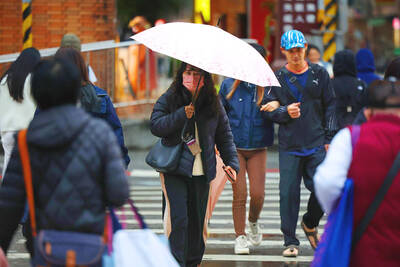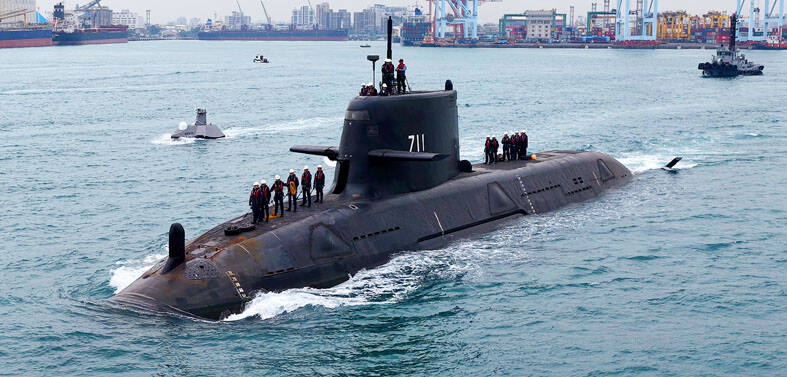Four years after the Republic of China (ROC) Marine Corps requisitioned its first order of Kestrel anti-armor rocket launchers, the military police and coast guard separately last month announced plans to buy the weapon next year.
The purchase decisions signal that the military considers the weapon — built by the Chungshan Institute of Science and Technology — to be viable and that the institute’s efforts to design arms and provide upgrades would receive state funding.
The Kestrel rocket launcher is a single-shot, shoulder-launched anti-armor weapon that fires either a high-explosive anti-tank warhead to engage vehicles with light to medium armor or a high-explosive “squash head” for use against buildings.
The biggest hurdle for domestic arms programs has been difficulty gaining the confidence of the end user: the armed forces.
For operational reasons, the military tends to favor foreign weapons systems with proven combat success, while its acceptance of indigenous designs has been cautious, even skeptical. Domestic weapon systems must often take long detours on the path from development to the field.
The launcher was no exception. Although the marines first used the weapon in 2014, their initial purchase was a small order placed due to urgent operational needs. Only after the marines gained confidence in the weapon did the corps place larger orders.
At a cost of NT$49.79 million (US$1.63 million), the Military Police Command plans to issue 445 launchers, 279 training launchers and eight simulators to units tasked with defending Taipei, the unit’s budget for next year showed.
The Coast Guard Administration plans to issue 84 launchers and 88 training launchers to coast guard garrisons on the Pratas Islands (Dongsha Islands, 東沙群島) and Spratly Islands (Nansha Islands, 南沙群島), at a cost of NT$11.12 million, the coast guard’s budget for next year showed.
The biggest potential client for the rocket launcher is the ROC Army, whose hand-held anti-tank weapon is the US-made M72 LAW, an aging weapon.
However, the army, which has agreed to a service-life extension program for its large stock of M72s, has remained tight-lipped concerning any Kestrel purchases, despite reviewing the data and evaluating the weapon.
As a weapon designed to be operated by a single soldier, the Kestrel’s tactical role is similar to that of the M72 — a light, mobile weapon for dismounted infantry soldiers.
The TOW-2A/B anti-tank guided missile launcher — the military’s other standard-issue anti-armor weapon — possesses greater lethality and a longer range, but it is heavier and typically mounted on vehicles or attack helicopters.
Filling the gap between the two weapon systems, the FGM-148 Javelin is a fire-and-forget anti-tank missile launcher meant for a crew of two that is light enough to be carried by soldiers in the field, but more powerful than the Kestrel or the M72.
Translated by staff writer Jonathan Chin

NUMBERS IMBALANCE: More than 4 million Taiwanese have visited China this year, while only about half a million Chinese have visited here Beijing has yet to respond to Taiwan’s requests for negotiation over matters related to the recovery of cross-strait tourism, the Tourism Administration said yesterday. Taiwan’s tourism authority issued the statement after Chinese-language daily the China Times reported yesterday that the government’s policy of banning group tours to China does not stop Taiwanese from visiting the country. As of October, more than 4.2 million had traveled to China this year, exceeding last year. Beijing estimated the number of Taiwanese tourists in China could reach 4.5 million this year. By contrast, only 500,000 Chinese tourists are expected in Taiwan, the report said. The report

Temperatures are forecast to drop steadily as a continental cold air mass moves across Taiwan, with some areas also likely to see heavy rainfall, the Central Weather Administration (CWA) said. From today through early tomorrow, a cold air mass would keep temperatures low across central and northern Taiwan, and the eastern half of Taiwan proper, with isolated brief showers forecast along Keelung’s north coast, Taipei and New Taipei City’s mountainous areas and eastern Taiwan, it said. Lows of 11°C to 15°C are forecast in central and northern Taiwan, Yilan County, and the outlying Kinmen and Lienchiang (Matsu) counties, and 14°C to 17°C

STEERING FAILURE: The first boat of its class is experiencing teething issues as it readies for acceptance by the navy, according to a recent story about rudder failure The Hai Kun (海鯤), the nation’s first locally built submarine, allegedly suffered a total failure of stern hydraulic systems during the second round of sea acceptance trials on June 26, and sailors were forced to manually operate the X-rudder to turn the submarine and return to port, news Web site Mirror Daily reported yesterday. The report said that tugboats following the Hai Kun assisted the submarine in avoiding collisions with other ships due to the X-rudder malfunctioning. At the time of the report, the submarine had completed its trials and was scheduled to begin diving and surfacing tests in shallow areas. The X-rudder,

DEMAND: The government should enact regulations in line with Austria and Germany to incorporate vegan nutrition into school meals, an advocate said More than 1,000 people yesterday marched in Taipei to promote veganism, calling for legislation to incorporate vegan diets into school lunches and the national net zero emissions program. Participants gathered on Ketagalan Boulevard in front of the Presidential Office Building for the march, which was organized by the Vegan Action Network (VAN). Former ambassador to Chad Chiu Chung-jen (邱仲仁), actor Yankee Yang (楊子儀) and actress Cindy Lien (連俞涵) attended the event. VAN member Marianne Chao (趙梅君) said that the campaign aimed to urge the government to promote vegan diets across schools and government agencies via legislation and national policies, which would help build